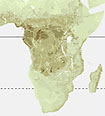U.N. officials unveiled an atlas that targets areas where better planning and conservation would provide double benefits: protecting rare wildlife and slowing global warming. The series of maps, introduced at

climate talks in Poznan, Poland, focus on the forests of Madagascar and the Amazon, regions with diverse wildlife and large amounts of carbon dioxide stored in trees and soil. Officials hope the atlas will help guide public policy in those regions, particularly when it comes to decisions on forest clearing. “When countries plan, they may wish to prioritize action in some areas ahead of others,” said Barney Dickson of the U.N. Environmental Programme’s World Conservation Monitoring Center. For instance, protection of forests in the Congo basin would also help preserve gorilla populations, and rare birds would benefit from preserving forests in Ecuador. Other regions targeted include the Amazon basin, the tip of South Africa and central Papua New Guinea. More than 18 million acres of forest was lost from 2000 to 2005, according to the U.N.